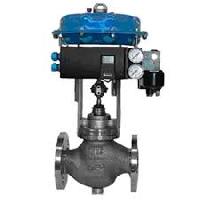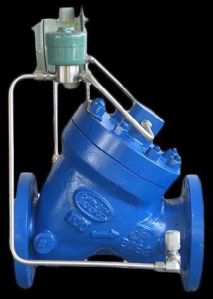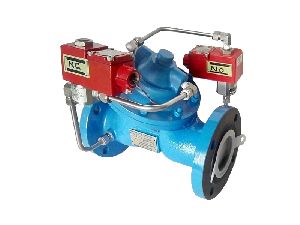
Digital Control Valves
1,000 - 500,000 Per Piece
10 Piece (MOQ)
In the world of industrial process control, digital control valves offer a modern and precise approach to regulating fluid flow. They combine the traditional functionality of a control valve with the advantages of digital technology. Here's a comprehensive breakdown of digital control valves and how they work: Function: · A digital control valve regulates fluid flow within a system by adjusting the position of a valve seat or opening. · Unlike traditional pneumatic control valves that rely on compressed air for actuation, digital control valves use an electric motor or solenoid to move the valve stem. · This movement is controlled by a digital signal, typically received from a control system or process controller. · The digital signal instructs the valve to open, close, or adjust its position to achieve the desired flow rate within the system. Components: · Electric Actuator: Replaces the pneumatic actuator of traditional valves. It converts the digital signal into precise motor movement, controlling the valve stem position. · Solenoid Valves (Optional): In some designs, solenoid valves might be used for pilot operation or fast opening/closing functions. · Position Sensor: Provides feedback on the actual valve stem position, ensuring the valve movement aligns with the digital control signal. · Control Electronics: The "brains" of the valve, responsible for interpreting the digital signal, controlling the motor or solenoid operation, and processing feedback from the position sensor. Benefits of Digital Control Valves: · High Accuracy and Precision: Digital control offers finer control over valve position compared to pneumatic systems, leading to more precise flow rate regulation. · Improved Response Time: Digital signals travel faster than compressed air, resulting in quicker valve response to changes in flow requirements. · Remote Monitoring and Control: Digital control valves can be easily integrated with control systems for remote monitoring, data logging, and configuration adjustments. · Reduced Maintenance: Digital valves eliminate the need for compressed air systems and associated maintenance requirements. · Enhanced Diagnostics: Digital control systems can provide diagnostic information on valve performance, aiding in proactive maintenance and troubleshooting. Applications of Digital Control Valves: Digital control valves find application in various industries due to their precise control and communication capabilities: · Chemical Processing Plants: Precisely controlling the flow of various chemicals within complex reaction and separation processes. · Oil and Gas Production: Regulating flow rates of crude oil, refined products, and natural gas during production, transportation, and refining. · Power Generation: Controlling fuel gas, cooling water, and other fluid flows within power plants for efficient energy generation. · Water and Wastewater Treatment: Accurately regulating water flow rates at various stages of treatment plants for optimal performance. · HVAC Systems: Precisely controlling hot and cold water flow rates within heating, ventilation, and air conditioning systems for efficient climate control. · Pharmaceutical Manufacturing: Maintaining strict flow control for sensitive materials within pharmaceutical production processes. Selection Considerations: Choosing the right digital control valve requires considering several factors: · Fluid Type: The valve material and design should be compatible with the fluid being handled. · Flow Rate Range: The valve needs to handle the expected minimum and maximum flow rates within the system. · Pressure Rating: The valve's pressure rating should exceed the system's maximum operating pressure. · Accuracy Requirements: Select a valve with an accuracy level that meets your specific flow control needs. · Communication Protocol: Ensure the valve's communication protocol (e.g., Modbus, HART) is compatible with your control system. · Safety Features: Consider fail-safe mechanisms and other safety features depending on the application's criticality. By understanding the workings, benefits, and selection considerations for digital control valves, you can leverage their precise control and digital communication capabilities to optimize flow regulation within your industrial processes.

Piston Digital Control Valves
100,000 - 2,500,000 Per Piece
1 Piece (MOQ)
Best Deals from Digital Control Valves

Digital Control Valve
Get Price Quote
This is an electrically actuated, hydraulically operated multi-function control valve. Used extensively in loading terminal automation systems in refineries and storage tanks of petroleum products for effective and accurate filling of tankers and railway wagons. It has two solenoid valves, receiving signal from batch controllers to position the valve for low flow/medium flow / high flow conditions as programmed.Size : 25NB - 400NB

Digital Control Valve (DCV)
Get Price Quote
Digital control valve: our digital control valve is an electrically actuated, hydraulically operated multi-function control valve. It can be used for local as well as remote controlled batching operations with electronic batch controller.

Digital Control Valves
Get Price Quote
An internal current control with the duty factor of the PWM signal as manipulated variable ensures that every value of the input signal, irrespective of the thermal condition of the coil, is unambiguously assigned a given value of the effective coil current.

Piston Type Digital Control Valve
Get Price Quote
Flow-Tek This is an electrically actuated, hydraulically operated multi-function control valve. Used extensively in loading terminal automation systems in refineries and storage tanks of petroleum products for effective and accurate filling of tankers and railway wagons. It has two solenoid valves, receiving signal from batch controllers to position the valve for low flow/medium flow / high flow conditions as programmed.

Diaphragm Digital Control Valves
Get Price Quote
Diaphragm Digital Control Valve is an electrically actuated, hydraulically operated multi-function control valve. It can be used for local as well as remote controlled batching operations with electronic batch controller. The valve also offers an in-built flow governing function DESIGN FEATURES Precision multi-stage opening and closing Fail-safe design Low pressure drop Bubble-tight seat design Flow rate control PRINCIPLE OF OPERATION The Diaphragm Digital Control Valve basically consists of a diaphragm operated main valve and two solenoid valves. Normally open (NO) solenoid connects the valve cover chamber to the upstream pressure, whereas normally closed (NC) solenoid connects the valve cover chamber to the downstream pressure. When the Diaphragm Digital Control Valve is used with an electronic batch controller, it can be digitally controlled by operating the solenoid valves through any of these three stages : when NO and NC solenoids are energized, the valve opens gradually. when NC solenoid is de-energized (keeping NO solenoid energized), the valve locks at its current position. when NO and NC solenoids are de-energized, the valve closes gradually. The operation of the valve is simple and is explained below. The total batch quantity delivered and controlled through the valve is divided into 7 stages (Refer graph) for the purpose of convenience. Initially both NO and NC solenoid valves are in de-energized condition. The NO valve applies high upstream pressure on the diaphragm, whereas the NC valve prevents this pressure from getting drained to the downstream side. The valve remains close as a result of this. Stage 1Both NO and NC solenoids are energized. NO valve now restricts the high upstream pressure from entering into the cover chamber. NC valve permits the pressure above the diaphragm to vent to the low downstream pressure. This creates a differential pressure across the diaphragm, the high upstream pressure acting from below the diaphragm opens the main valve and allows the flow to start through the valve. Stage 2As the flow rate reaches predefined value (set in the batch controller as “Low Flow Start”) the NC valve is de-energized. This prevents further draining of the chamber and locks the valve at this flow rate. Initial delivery at slow speed avoids splashing of product and also avoids the generation of static charge. Stage 3When sufficient quantity is delivered at the slow speed, the NC valve is energized again. This allows further draining of the chamber and hence increases the flow. Stage 4When the flow reaches to the maximum level (set in the batch controller), the NC solenoid is de-energized. This maintains the constant high flow rate for the remaining batch. During this stage, the flow rate control is done by the batch controller. When a number of flow meters are connected to the same pump, stopping (or starting) one or more meters increases (or decreases) the flow rate at the remaining meters. When the flow rate increases, the NO solenoid is energized momentarily. This injects some high pressure in the cover chamber and makes the valve to throttle in order to maintain the set flow rate. If the flow rate decreases, the NC solenoid is energized momentarily. This allows slight draining of the chamber and allows the valve to open further in order to maintain the set flow rate. Stage 5At the end of the batch, the NO solenoid is de-energized. This injects high upstream pressure into the cover chamber and throttles the valve. Stage 6When the valve throttles sufficiently to achieve the predefined slow closing flow rate (set in the batch controller), the NO solenoid is energized. This maintains the uniform flow rate. Stage 7When the batch quantity is delivered, the NO solenoid is de-energized. (NC solenoid is already de-energized.) This applies high upstream pressure into the cover chamber, which makes the main valve to close completely to achieve bubble-tight shut-off. Note: The number of stages during opening and closing are programmed in the batch controller and can be as many as desired. One stage during opening and two during closing are recommended. Caution: Sufficient pumping flow rate should be available to achieve the flow parameters set in the electronic batch controller. In the absence of this, there are chances of delayed response in closure, resulting in valve over-run.

Digital Control Valve
70,000 Per Piece

Digital Control Valve
6,000 Per unit

Digital Control Valve
30,000 Per Piece
1 Piece (MOQ)

Digital Control Valve
Get Price Quote
Digital Control Valve, oil control valve, Needle Valve, speed control valve

Digital Control Valve
Get Price Quote
Digital Control Valve

Digital Control Valve
Get Price Quote
Digital Control Valve, power cylinder

EmechEmech Digital Control Valves
Get Price Quote
EmechEmech Digital Control Valves, Radiator

Digital Control Valve
Get Price Quote
Digital Control Valve, Programmable PID Temperature Controller

Digital Control Valves For Terminal Automation
Get Price Quote
Digital Control Valves For Terminal Automation

Digital Control Valves,
Get Price Quote
Digital Control Valves

Digital Control Valve
Get Price Quote
Digital Control Valve

Digital Control Valve
Get Price Quote
Digital Control Valve, Stainless Steel Y Type Pneumatic Control Valve

Digital Control Valve
Get Price Quote
Digital Control Valve, Bellow Sealed Valves, Flame Arrestor